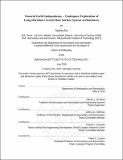| dc.contributor.advisor | Olivier L. de Weck. | en_US |
| dc.contributor.author | Do, Sydney | en_US |
| dc.contributor.other | Massachusetts Institute of Technology. Department of Aeronautics and Astronautics. | en_US |
| dc.date.accessioned | 2016-12-05T19:10:21Z | |
| dc.date.available | 2016-12-05T19:10:21Z | |
| dc.date.copyright | 2016 | en_US |
| dc.date.issued | 2016 | en_US |
| dc.identifier.uri | http://hdl.handle.net/1721.1/105554 | |
| dc.description | Thesis: Ph. D., Massachusetts Institute of Technology, Department of Aeronautics and Astronautics, 2016. | en_US |
| dc.description | This electronic version was submitted by the student author. The certified thesis is available in the Institute Archives and Special Collections. | en_US |
| dc.description | Cataloged from student-submitted PDF version of thesis. | en_US |
| dc.description | Includes bibliographical references (pages 577-599). | en_US |
| dc.description.abstract | In recent years, an unprecedented level of interest has grown around the prospect of sending humans to Mars for the exploration and eventual settlement of that planet. With the signing of the 2010 NASA Authorization Act, this goal became the official policy of the United States and consequently, has become the long-term objective of NASA's human spaceflight activities. A review of past Mars mission planning efforts, however, reveals that while numerous analyses have studied the challenges of transporting people to the red planet, relatively little analyses have been performed in characterizing the challenges of sustaining humans upon arrival. In light of this observation, this thesis develops HabNet - an integrated Habitation, Environmental Control and Life Support (ECLS), In-Situ Resource Utilization (ISRU), and Supportability analysis framework - and applies it to three different Mars mission scenarios to analyze the impacts of different system architectures on the costs of deploying and sustaining a continuous human presence on the surface of Mars. Through these case studies, a number of new insights on the mass-optimality of Mars surface system architectures are derived. The most significant of these is the finding that ECLS architecture mass-optimality is strongly dependent on the cost of ISRU - where open-loop ECLS architectures become mass-optimal when the cost of ISRU is low, and ECLS architectures with higher levels of resource recycling become mass-optimal when the cost of ISRU is high. For the Martian surface, the relative abundance of resources equates to a low cost of ISRU, which results in an open-loop ECLS system supplemented with ISRU becoming an attractive, if not dominant surface system architecture, over a range of mission scenarios and ISRU performance levels. This result, along with the others made in this thesis, demonstrates the large potential of integrated system analyses in uncovering previously unseen trends within the Mars mission architecture tradespace. By integrating multiple traditionally disparate spaceflight disciplines into a unified analysis framework, this thesis attempts to make the first steps towards codifying the human spaceflight mission architecting process, with the ultimate goal of enabling the efficient evaluation of the architectural decisions that will shape humanity's expansion into the cosmos. | en_US |
| dc.description.statementofresponsibility | by Sydney Do. | en_US |
| dc.format.extent | 599 pages | en_US |
| dc.language.iso | eng | en_US |
| dc.publisher | Massachusetts Institute of Technology | en_US |
| dc.rights | M.I.T. theses are protected by copyright. They may be viewed from this source for any purpose, but reproduction or distribution in any format is prohibited without written permission. See provided URL for inquiries about permission. | en_US |
| dc.rights.uri | http://dspace.mit.edu/handle/1721.1/7582 | en_US |
| dc.subject | Aeronautics and Astronautics. | en_US |
| dc.title | Towards Earth independence - tradespace exploration of long-duration crewed Mars surface system architectures | en_US |
| dc.type | Thesis | en_US |
| dc.description.degree | Ph. D. | en_US |
| dc.contributor.department | Massachusetts Institute of Technology. Department of Aeronautics and Astronautics | |
| dc.identifier.oclc | 961321393 | en_US |
